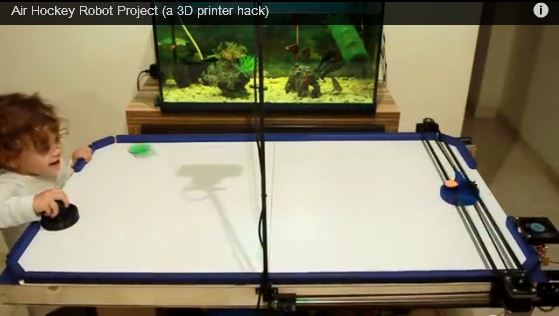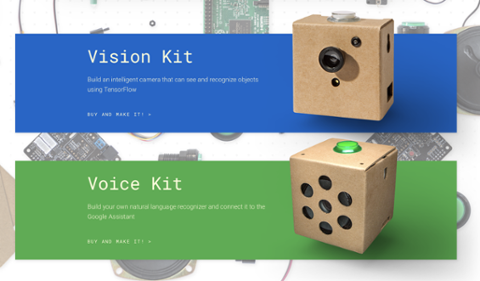[caption id="attachment_17191" align="aligncenter" width="559"] Jose Julio's daughter facing off at air hockey against Skynet.[/caption] Attention partnered, parented geeks: It's time to give up on this year's race for Global Dad Champion. The season's been won by Canary Islander Jose Julio, a do-it-yourself robotics addict, drone developer and "IMU rockstar" who built his daughter a competitive robotic air-hockey table using an old PC, the an EYE camera from a PS3, bits of a 3D printer (which he built himself, then cannibalized), a sense of humor and good supply of googly eyes. The Air Hockey Robot project (video here) is the latest in a long line of Julio robot-coolness, which includes a host of Arduino-based remote-control quadrocopters he's built, flew, videotaped and posted on DIYDrones since 2009. Julio – who said during a 2011 Q&A on DIYDrones that he works days for a publisher of geographic information systems – earned the monicker "IMU rockstar" for his contributions and the quality of the work he contributed to the open-source Arduino and Arduino IMU (ArduIMU) UAV systems. According to other developers at DIYDrones, Julio is particularly adept at writing code for in inertial measurement units (IMU), a miniature sensor that uses a series of accelerometers, gyroscopes and magnetometers to detect a UAV's speed and orientation as well as external forces like gravity, wind or the sudden incursion of buildings to help UAV pilots fly more effectively. Julio's own favorite projects are a 12.5-inch, 162-gram, stable and consistently controllable multi-rotor mini-copter, and a 13-inch, 70gram "all-rotating" drone copter whose single rotor makes up most of the body of the bot. His first grand slam in the Geek Dad competition, however, came in October 2013 with a fully 3D-printed, mobile, WiFi-controlled googly-eyed rolling breadbox called B-Robot. The 'bot uses SegWay-like dual wheels and tils-to-move design that makes it extremely maneuverable and relatively stable; it's controllable from a smartphone, and can detect and avoid obstacles as it zooms and dips around the maker's Canary Islands home. While entertaining and a good proof of concept for 3D-printed parts, B-Robot was not sufficiently impressive to maintain the adulation of Julio's air-hockey-playing, somewhat robot-jaded daughter. "My daughter loves the Air Hockey game and I love robotics so one day an idea born in my mind... can I construct...??... Mmmmm .... it seemed very complicated and with many unresolved questions (puck detection??, robot speed??), but that is also part of the fun...," Julio blogged about the Air Hockey Robot project. Julio's material list is a recycler's to-do list. The bearing rods and much of the robot's structure comes from a RepRap 3D printer Julio built himself to make pieces for the B-Robot. The puck levitates using a cushion of air blown by salvaged fans of two PCs. The robot can "see" using a PS3 EYE camera rescued from a game console, along with vision software Julio developed himself. The vision system and speed of the robot's reactions are good enough that "the robot could easily beat the child," Julio wrote. "An adult with some experience can still [beat] the robot, but I am sure that with some more small improvements it is going to be really hard to beat." Julio gets extra style points for his effective use of googly eyes and eyebrows (on the human's puck pusher), and extra gender-neutral parent points for building a really cool robotic action game for a girl. (The number of boys participating in middle- and high-school robotics competitions in the U.S. is several times the number of girls participating, according to a study published in the July 2013 Journal of Technology, Management and Applied Engineering. Despite a particularly severe geek gender gap among fledglings, the robotics industry boasts a large cohort of high-profile, highly successful former girls, including iRobot, Inc. co-founder Helen Grenier, Amy Villeneuve, president and COO of giant industrial robot-maker KIVA Systems, and leading social/personal-robotics researcher and designer Cynthia Breazeal of MIT Media Lab. Most got involved in robotics early; there is no indication how many were childhood fans of air hockey.) Julio gets robotics-geek-DIY-community points for his careful documentation of the build process and the materials list, and illustrated step-by-step instructions that could allow less robo-intellectually agile prospective dad-champion contenders to build their own (almost-functioning) robot air hockey tables as well. (Plans are available for download here. You have to arrange for your own offspring for whom to build it.) Prospective competitors should remember, however, that the 2014 season has ended and Julio has won, unless they come up with something similarly wicked at least two months from now ("year" and "season" in offspring-judged competitions being dependent on the extremely short attention spans of… hey, look, a robot squirrel!). Image: Jose Julio
Jose Julio's daughter facing off at air hockey against Skynet.[/caption] Attention partnered, parented geeks: It's time to give up on this year's race for Global Dad Champion. The season's been won by Canary Islander Jose Julio, a do-it-yourself robotics addict, drone developer and "IMU rockstar" who built his daughter a competitive robotic air-hockey table using an old PC, the an EYE camera from a PS3, bits of a 3D printer (which he built himself, then cannibalized), a sense of humor and good supply of googly eyes. The Air Hockey Robot project (video here) is the latest in a long line of Julio robot-coolness, which includes a host of Arduino-based remote-control quadrocopters he's built, flew, videotaped and posted on DIYDrones since 2009. Julio – who said during a 2011 Q&A on DIYDrones that he works days for a publisher of geographic information systems – earned the monicker "IMU rockstar" for his contributions and the quality of the work he contributed to the open-source Arduino and Arduino IMU (ArduIMU) UAV systems. According to other developers at DIYDrones, Julio is particularly adept at writing code for in inertial measurement units (IMU), a miniature sensor that uses a series of accelerometers, gyroscopes and magnetometers to detect a UAV's speed and orientation as well as external forces like gravity, wind or the sudden incursion of buildings to help UAV pilots fly more effectively. Julio's own favorite projects are a 12.5-inch, 162-gram, stable and consistently controllable multi-rotor mini-copter, and a 13-inch, 70gram "all-rotating" drone copter whose single rotor makes up most of the body of the bot. His first grand slam in the Geek Dad competition, however, came in October 2013 with a fully 3D-printed, mobile, WiFi-controlled googly-eyed rolling breadbox called B-Robot. The 'bot uses SegWay-like dual wheels and tils-to-move design that makes it extremely maneuverable and relatively stable; it's controllable from a smartphone, and can detect and avoid obstacles as it zooms and dips around the maker's Canary Islands home. While entertaining and a good proof of concept for 3D-printed parts, B-Robot was not sufficiently impressive to maintain the adulation of Julio's air-hockey-playing, somewhat robot-jaded daughter. "My daughter loves the Air Hockey game and I love robotics so one day an idea born in my mind... can I construct...??... Mmmmm .... it seemed very complicated and with many unresolved questions (puck detection??, robot speed??), but that is also part of the fun...," Julio blogged about the Air Hockey Robot project. Julio's material list is a recycler's to-do list. The bearing rods and much of the robot's structure comes from a RepRap 3D printer Julio built himself to make pieces for the B-Robot. The puck levitates using a cushion of air blown by salvaged fans of two PCs. The robot can "see" using a PS3 EYE camera rescued from a game console, along with vision software Julio developed himself. The vision system and speed of the robot's reactions are good enough that "the robot could easily beat the child," Julio wrote. "An adult with some experience can still [beat] the robot, but I am sure that with some more small improvements it is going to be really hard to beat." Julio gets extra style points for his effective use of googly eyes and eyebrows (on the human's puck pusher), and extra gender-neutral parent points for building a really cool robotic action game for a girl. (The number of boys participating in middle- and high-school robotics competitions in the U.S. is several times the number of girls participating, according to a study published in the July 2013 Journal of Technology, Management and Applied Engineering. Despite a particularly severe geek gender gap among fledglings, the robotics industry boasts a large cohort of high-profile, highly successful former girls, including iRobot, Inc. co-founder Helen Grenier, Amy Villeneuve, president and COO of giant industrial robot-maker KIVA Systems, and leading social/personal-robotics researcher and designer Cynthia Breazeal of MIT Media Lab. Most got involved in robotics early; there is no indication how many were childhood fans of air hockey.) Julio gets robotics-geek-DIY-community points for his careful documentation of the build process and the materials list, and illustrated step-by-step instructions that could allow less robo-intellectually agile prospective dad-champion contenders to build their own (almost-functioning) robot air hockey tables as well. (Plans are available for download here. You have to arrange for your own offspring for whom to build it.) Prospective competitors should remember, however, that the 2014 season has ended and Julio has won, unless they come up with something similarly wicked at least two months from now ("year" and "season" in offspring-judged competitions being dependent on the extremely short attention spans of… hey, look, a robot squirrel!). Image: Jose Julio


